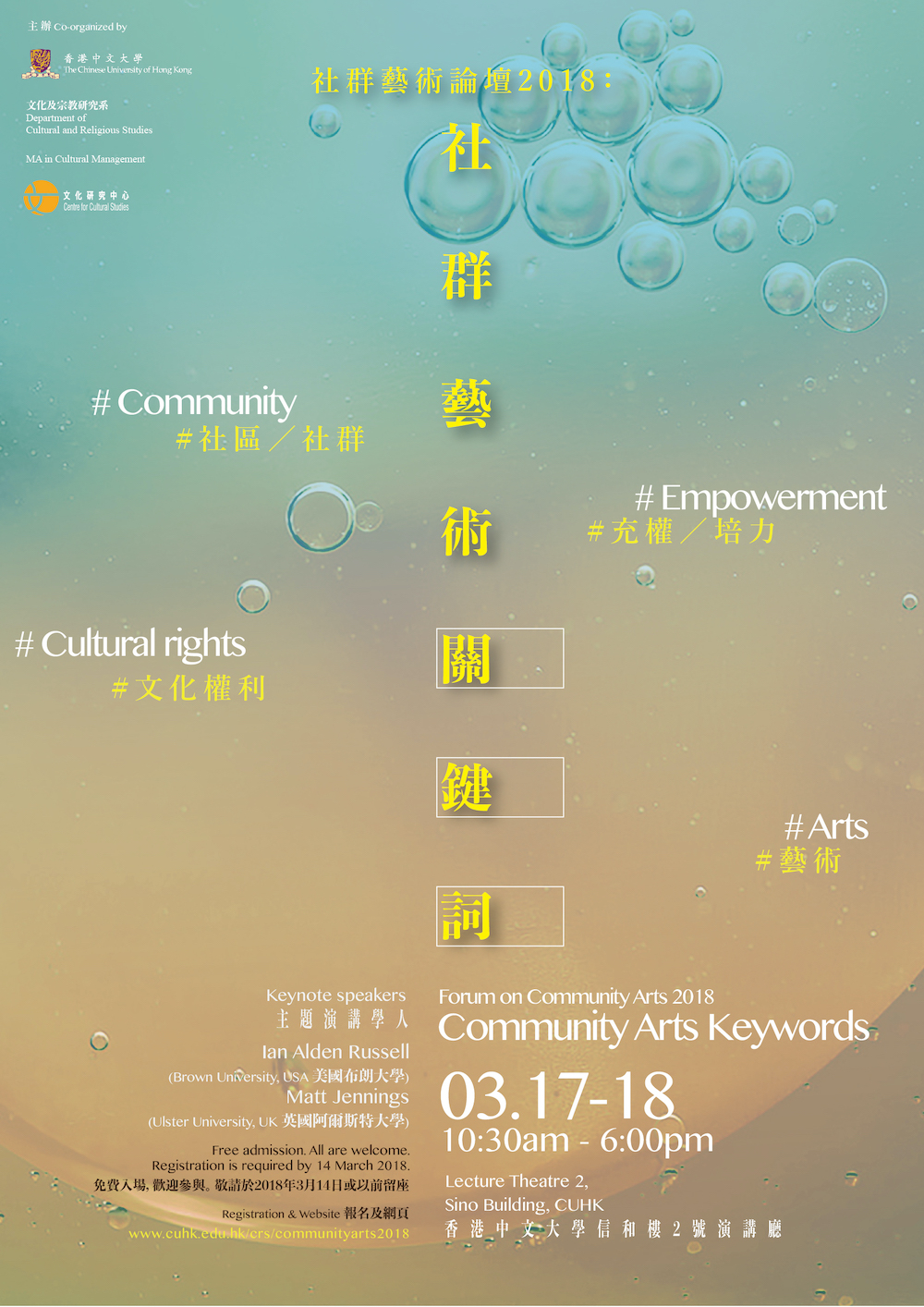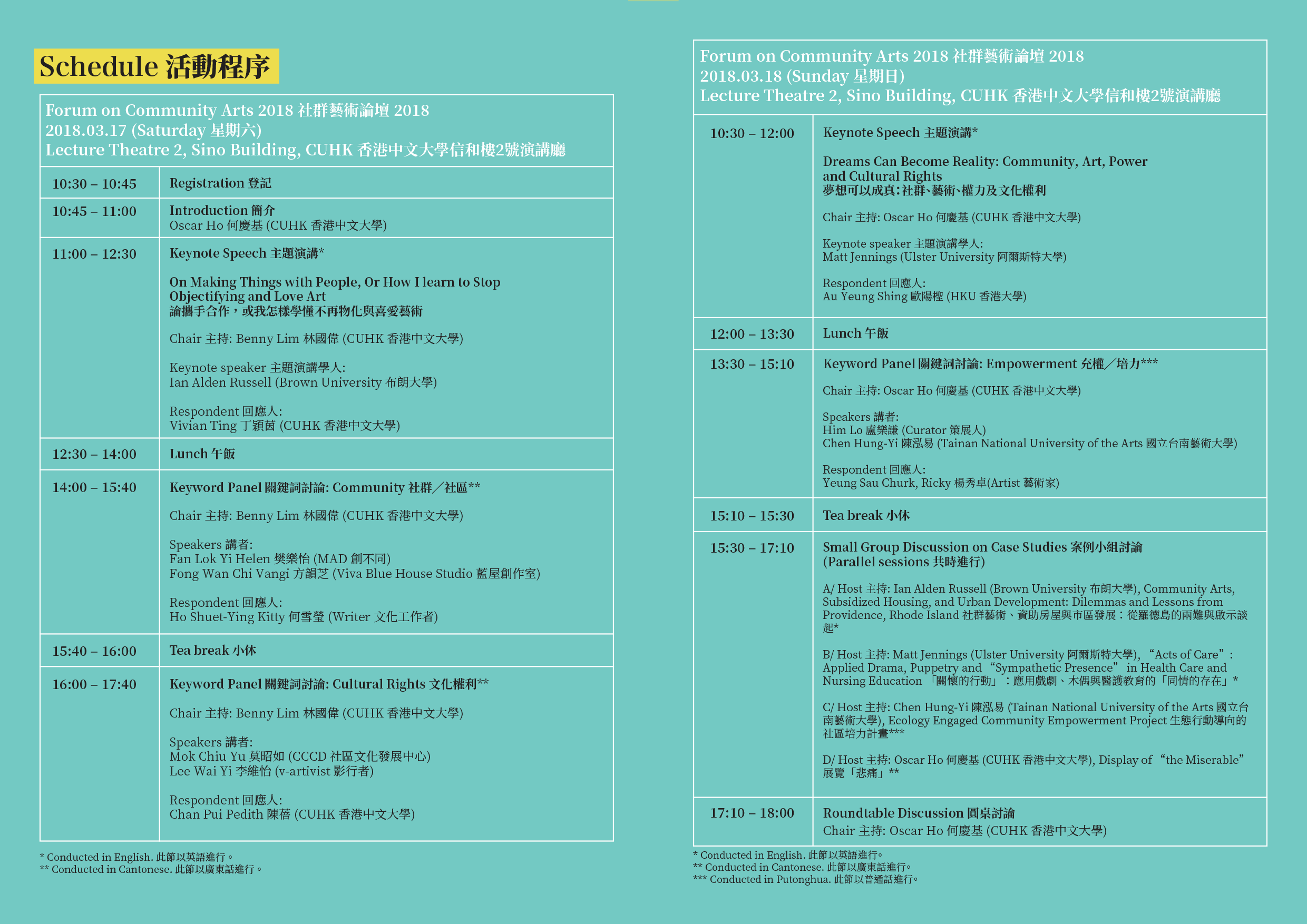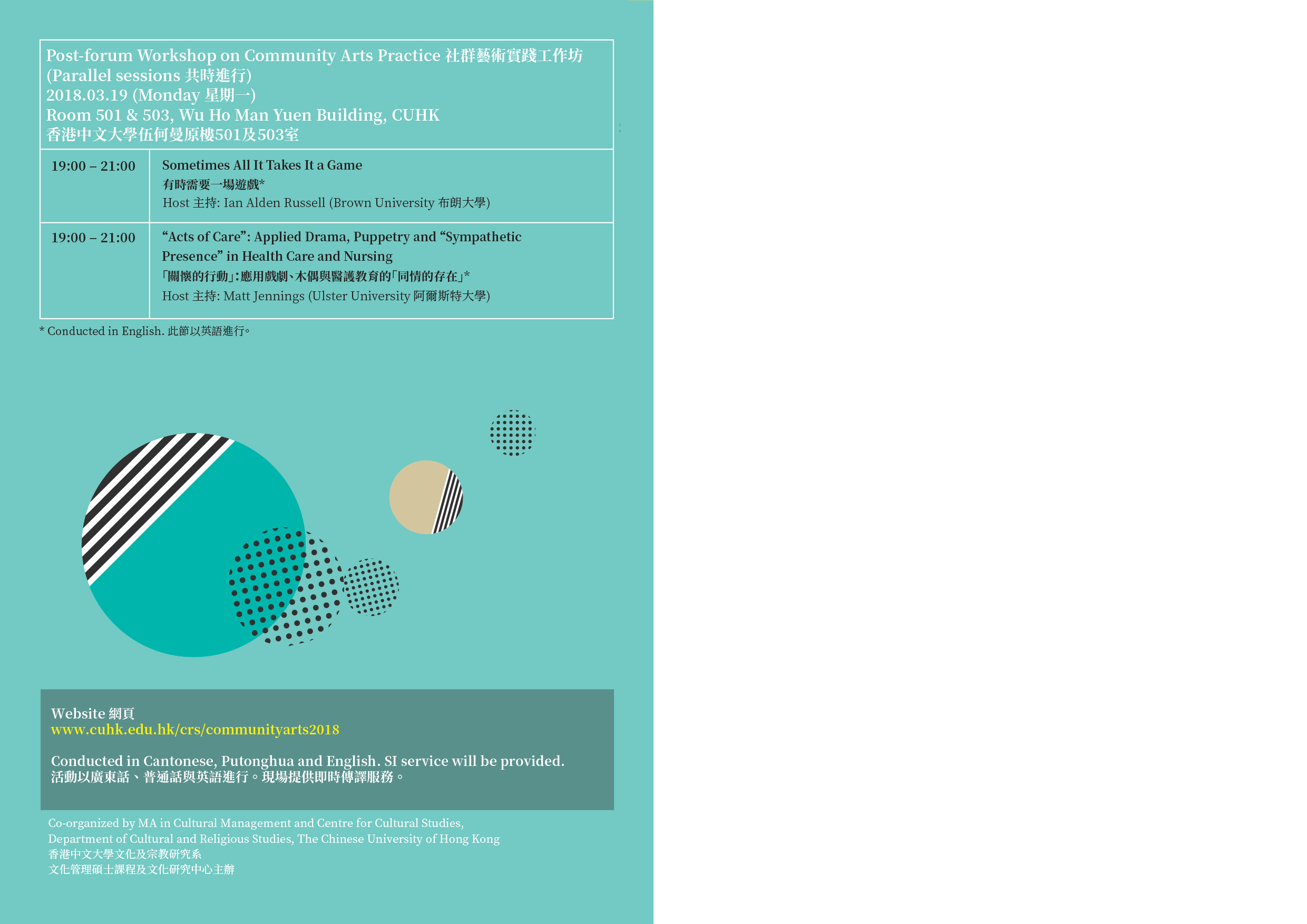
Forum on Community Arts 2018
Community Arts Keywords
社群藝術論壇2018
社群藝術關鍵詞
2018.03.17-18 | 10:30am – 6:00pm
Lecture Theatre 2, Sino Building, CUHK 香港中文大學信和樓2號演講廳
In the last ten years Hong Kong has witnessed a rapid growth of community arts, when arts as well as social service groups are taking active initiatives in utilizing arts to meet various communal needs. Responding to the urgent needs, many groups jump right into actions and learn the techniques and related knowledge as they move on. Recognizing the needs for support in the elaboration of the practice and understanding of community arts, the MA Programme in Cultural Management and the Centre of Cultural Studies at CUHK have been annually organizing forum in community arts since 2014. In the past, specific topics such as heritage preservation, the silver hair generation, etc., were identified each year, with talks and workshops organized to nurture practical skills, creative planning and to generate discussions within the identified areas.
This year we decided to talk on a slightly different route, focusing on the conceptual and ethical part of community arts. As community arts frequently deals with the marginal and the underprivileged, sensibility and clearly set operational principles are essential. The forum identifies a few ‘keywords’ commonly used in community arts to start a discussion of those frequently used, seemingly simple but in fact highly complex terms, such as community, arts, empowerment and cultural rights. After many years of fieldwork in the community, we have progressed to a point when we need to think about the philosophies and ethics relating to a highly complex form of arts that takes arts out of the market and brings it back to the people.
過去十年香港的社群藝術出現空前發展,藝術和社福機構紛紛籌辦文化藝術活動,以滿足各式各樣的公眾需要。因應社會的迫切需求,不少機構邊學邊做,從行動中積累知識和經驗。有見及此,香港中文大學文化管理碩士課程及文化研究中心,自2014年以來舉辦年度社群藝術論壇,每年針對不同議題如保育、銀髮族群等,借鏡各地經驗,反思在地實踐。論壇並設著重實踐的工作坊,希望引發創意構思和討論交流。
今年我們決定走稍為不同路線,把焦點轉向探討社群藝術的理念和道德等議題。由於社群藝術接觸不少邊緣、弱勢社群,實踐者需要敏銳觸覺和清晰運作守則,實有必要深入思考這方面的課題。本屆論壇將集中探討在社群╱社區藝術常用,看似簡單但其實相當複雜的詞彙如「Community社群╱社區」、「Arts藝術」、「Empowerment 充權╱培力」、「Cultural rights文化權利」等。香港探索社群藝術已有一定時間,諸多想法正在醞釀轉化,我們是時候進一步從理念和道德價值角度,探討這個與社群同在、互動、共生的藝術實踐類型。
論壇日程 Programme Schedule


Keynote Speech 主題演講
On Making Things with People, Or How I learn to Stop Objectifying and Love Art
論攜手合作,或我怎樣學懂不再物化與喜愛藝術
Ian Alden Russell
(Brown University, USA 美國布朗大學)
There are many competing definitions and understandings of what “art” is. Likewise, the conceptions of what constitutes a “community” can be as multiple as there are groups of people who identify as one. Despite the multiplicity of interpretations, dominant legislative policies relating to both art and community stem from an understanding of art as an object and community as a bounded group of people. Though artifacts may appear to be static objects that signify fixed groups of people, one need only work on an archaeological site for a short time to appreciate that the production of the past is collaborative. The same is true in the arts. Countless individuals contribute time, energy, and their agency to the production and presentation of art. Far from static objects, artworks and their presentation are the ongoing becoming of grand collaborative and creative acts. This keynote takes inspiration from cultural heritage, film, theatre, and the performing arts in order to reframe visual art and make visible the many hands and voices that sustain it within our communities.
何為藝術,各有不同且互相競逐的定 義與理解。 「社群」這概念,基於一群人如何建立群體的認同,也可以是同樣的多元化 。儘管存在不同的詮釋,主導藝術及社群的法案和政策,往往把視「藝術」為實質個體而「社群」為指定的群體。縱使手工藝品看似寂然不動、只涉及某特定群體,但若你曾短暫到訪考古遺址,便不難體會到過去的製作是集體共同製作的產品。藝術也如是。無數人付出時間心力,配合相關機構渠道去製作和表達藝術。藝術及其展現,遠非靜態的個體,而是一個持續且逐步發生的合作和集體創作。這次主題演講靈感源自文化遺產、電影、劇場及表演藝術,以重構視覺藝術那維繫社群當中的紛紜聲音和手法。
17.03.2018 | 11:00-12:30
Lecture Theatre 2, Sino Building, CUHK 香港中文大學信和樓2號演講廳
Conducted in English 以英語進行
Dreams Can Become Reality: Community, Art, Power and Cultural Rights
夢想可以成真:社群、藝術、權力與文化權利
Matt Jennings
(Ulster University 阿爾斯特大學)
The potential benefits of community arts practice and participation are social, personal and artistic.
Community arts can increase awareness of social issues; improve community health and wellbeing;
develop solidarity within and between community groups; support economic development; improve security and quality of life; and help people to celebrate shared identity and diversity.
The best community arts practices support the cultural, social and economic development and autonomy of community groups and individuals. As Baz Kershaw has said: “The intention of community theatre is to strengthen the self-determination of the community, to contribute to the empowerment of the community, and through that to augment the ideological survival of the community” (1992, 66). In this sense, ‘empowerment’ suggests that individuals and groups can develop their capacity to learn, imagine and change themselves and their world for the better. However, some uses of the term ‘empowerment’ can actually undermine this intention. ‘Empowerment’ can reinforce an unbalanced relationship, whereby someone has to ‘give’ power to someone else. By contrast, community arts practice can ‘enable’ people to recognise and implement the power that they already have, individually and collectively.
This presentation will discuss aspects of community, power, art, and cultural rights, drawing on examples of practice from the UK, Ireland, Australia and Hong Kong. Matt Jennings has worked in Northern Ireland since the 1998 Belfast Agreement established a peace process, after 30 years of armed conflict (known locally as ‘The Troubles’). The first example of practice emerges from this context. We shall investigate the significance of conceptions of community and identity in the context of a community performance project, Theatre of Witness.
Power, both political and personal, is a key theme of community arts practice, particularly following the international popularity of Theatre of the Oppressed (Boal 1998). This presentation will investigate issues of power in relation to the role of state security forces in Northern Ireland, with specific reference to ‘Crows on the Wire’, a theatre and education project addressing the experience of police officers during and after the conflict.
Art has the capacity to create aesthetic objects and events out of our experiences, to help us reflect on what we think and feel about our place in the world. We will look at the aesthetics of co-creation in the work of UK director, Alan Lyddiard (Community Arts International), who has developed original community performances with groups around the world, most recently in China and Hong Kong. In addressing cultural rights, we will also look at some of the recent work of the award-winning Australian company, Big hArt. Big hArt have developed an approach to working with community groups, including indigenous Australian communities, that not only presents their experiences and concerns in powerful works of art, but also promises to deliver on policy objectives that promote and establish legal protection for the civil rights of their co-creators.
實踐和參與社群藝術可為藝術、個人以至社會帶來好處。社群藝術可提高人們對社會議題的意識,改善社群的健康與福祉,建立社群之間的團結,支持經濟發展,提高生活的安全感與素質,以及幫助群眾擁抱共享的身份與多元性。
良好的社群實踐支持文化、社會與經濟方面的發展,以及提升社群與個體的自主。英國另類劇場與社區劇場導演巴茲.克索曾說:「社區劇場的本意是強化社群的自決能力、幫助社群充權和藉此增加社群意識型態的流傳。」(1992,66)。從這個意義上,「充權」是指個體與群體能夠發展他們學習、想像與改善自我和世界的能力。然而,部分「充權」的實踐卻顛覆以上原意,「充權」 或反過來強化不平等的關係,因一些人的能力需要由他人「賜予」。相反,社群藝術本意是「激發」群眾意識,並實踐其早已存在的個人及集體力量。
是次演講將以英國、愛爾蘭、澳洲與香港的例子,討論社群、權力、藝術與文化權利四個方面。自1998年《貝爾法斯特協議》建立和平進程,結束30年的武裝衝突(華文世界稱為「北愛爾蘭問題」),Matt Jennings 一直在當地工作。第一個例子出自上述背景。我們透過《目擊者的劇場》社區表演計劃,探討「社群」與「身份」兩概念的意義。
政治與個人的力量,是社群藝術實踐的關鍵主題,在此參照國際著名的《被壓迫者劇場》(波瓦,1998)。這次演講以處理當地警官在衝突期間及期後的經驗的「電纜線上的烏鴉」劇場及教育計劃為例,探討權力的議題,及北愛爾蘭國家安全部隊的角色。
藝術讓我們具備能力以自身經驗,創造美學物品和事件,幫助我們反思在身處地方的所思所想。我們會研究國際社區藝術英國總監Alan Lyddiard 的共創美學,他與世界各地的群體合作,近期活躍於中國與香港,發展原創的社區表演。至於文化權利,我們將研究澳洲的得獎機構Big hArt的近期作品。Big hArt建立與社群團體合作的方式,如與澳洲原住民社群合作,不但透過富感染力的藝術創作表述他╱她們的經驗與關注,還承諾倡議政策目標,立法保障其共同創作者的公民權利。
18.03.2018 | 10:30-12:00
Lecture Theatre 2, Sino Building, CUHK 香港中文大學信和樓2號演講廳
Conducted in English 以英語進行

